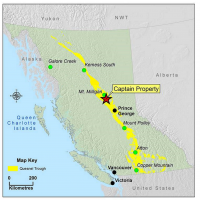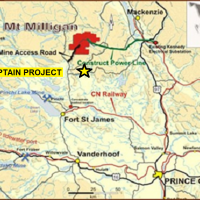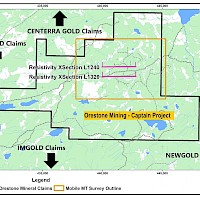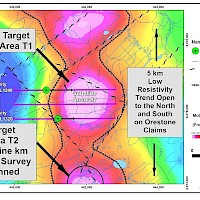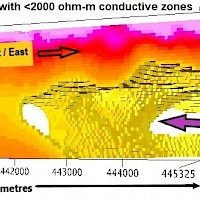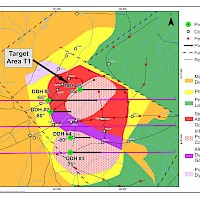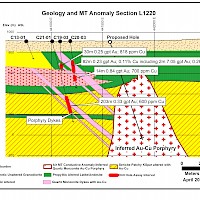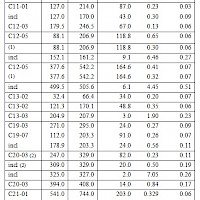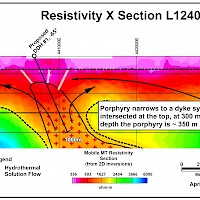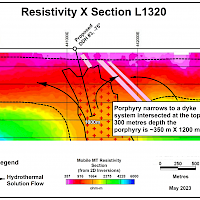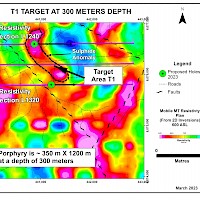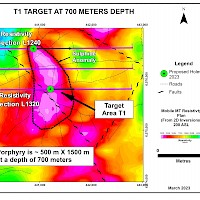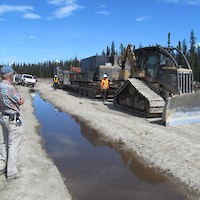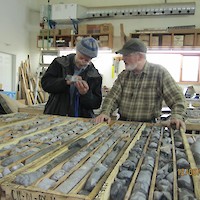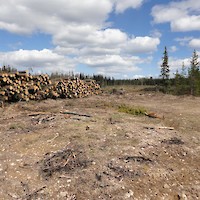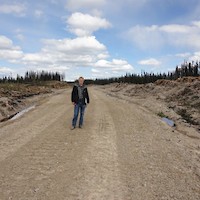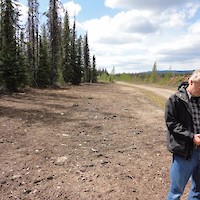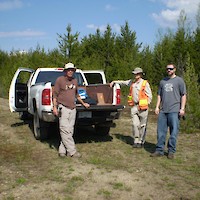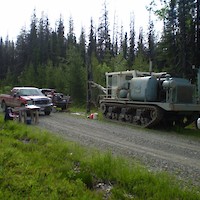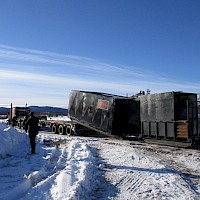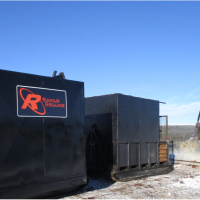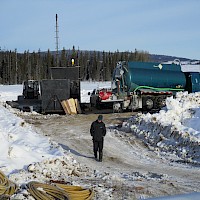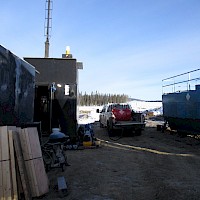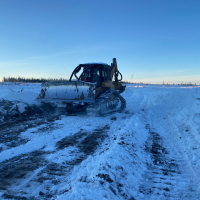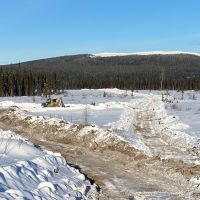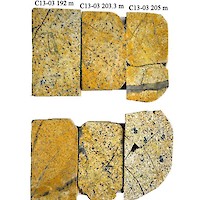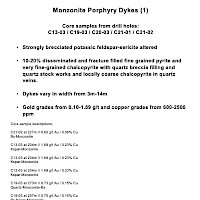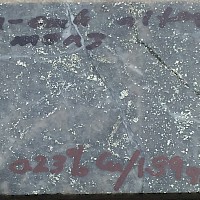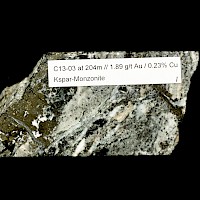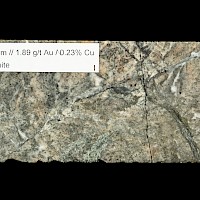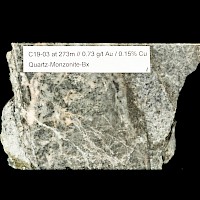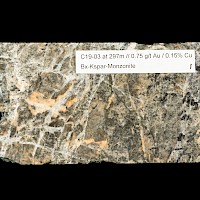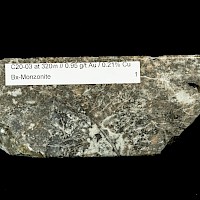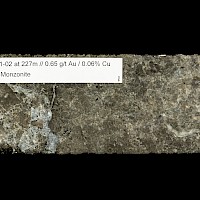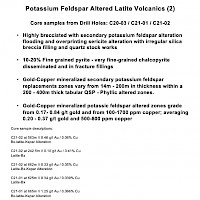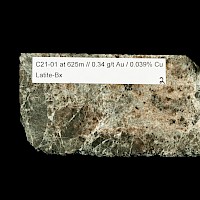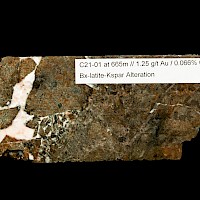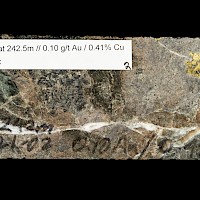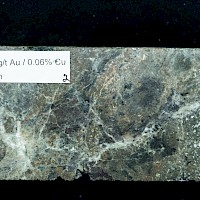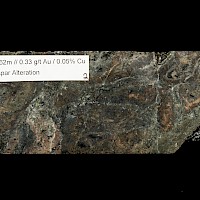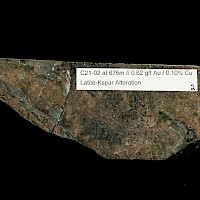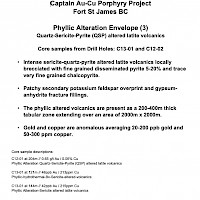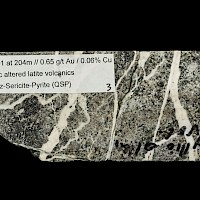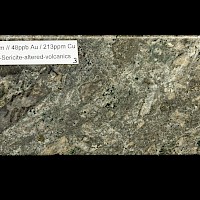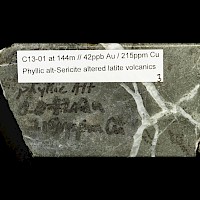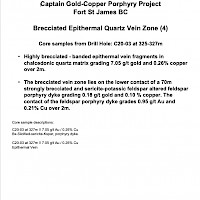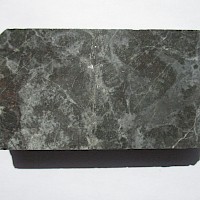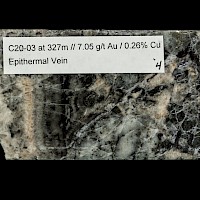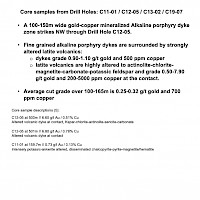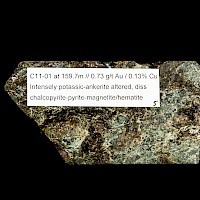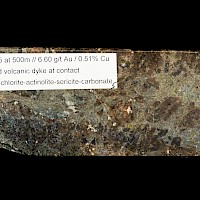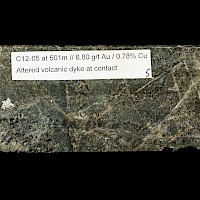Captain Property
The 100% owned Captain Project is located 150 km north of Prince George, British Columbia, in the prolific Quesnel Trough terrane which hosts a number of copper-gold and copper-molybdenum porphyry deposits including the Mt Milligan gold-copper deposit located just 30 km north of Captain. The Company currently controls 105 sq kilometres in the politically-safe jurisdiction of British Columbia. The area boasts year-round road access and excellent infrastructure.
CURRENT EXPLORATION
Exploration since 2019, has focused on locating the source of a high grade calc-alkaline potassium feldspar kspar-sericite monzonite porphyry inclusion in a post mineral dyke in drill hole C13-03. This intersection and re-logging of previous drill holes C12-03 and C19-03 confirmed the presence, to the east of a central magnetic high, of a large pottasium feldspar kspar-sericite altered calc-alkaline porphyry system that is co-incident with a magnetic low area measuring 600m by 1300m.
Combined holes C20-03, C21-01, and C21-02 outlined a tabular, sericite altered envelop 500 metres thick along a strike length of 800 metres and a width in excess of 1000 metres (500m x 800m x1000m). This represents a large volume of intensely hydrothermally altered latite/monzonite volcanic rocks with thick zones of potassic alteration containing gold-copper mineralization: two 82-85 metre long intercepts in the north (“Cross Section A”); and a 90 metre long intercept in the south (“Cross Section B”). This environment indicates the presence of a large gold-copper porphyry system with the lower intersection in drill hole C21-02 indicating the potential for higher grads.
A Magneto Telluric (MT) geophysical survey conducted in the summer of 2021 outlined a large, pronounced low resistivity / high conductivity anomaly over 800 metres in width starting at a depth of 500 metres, extending to a depth of over 900 metres. This conductive body was inferred to be the sulphide rich mineralizing intrusive which altered and mineralized the volcanic section to the west in the area of previous drilling.
In January 2022, a single drill hole C22-01 was drilled to the west of a major NW trending fault to test the Magneto Telluric (MT) anomaly. The drill hole intersected a 675 meter thick barren section of andesitic volcanics and volcano-clastics and a sequence of highly conductive graphitic sediments separated by a 75m thick potassic altered porphyry sill.
The interpretation based on these results is that the northwest fault uplifted the stratigraphic sequence to the east with the graphitic sediments causing the MT anomaly.
Further work will concentrate on the area to the west of the Northwest trending fault where previous drilling has identified gold-copper mineralization within potassic altered volcanic and intrusive units within a large, approximately 2km X 2km halo of phyllic alteration.
Table of Significant Drill Hole Intersections
Drill Hole
From
To
Interval m
g/t gold
% copper
C09-05
134.1
137.2
3.1
0.35
0.160
C11-01
127.0
214.0
87.0
0.23
0.027
incl
127.0
170.0
43.0
0.30
0.087
C12-03
179.5
246.5
67.0
0.13
0.055
C12-05
88.1
206.9
118.8
0.65
0.060
(1)
88.1
206.9
118.8
0.30
0.060
incl
152.1
161.2
9.1
6.46
0.270
C12-05
377.6
542.2
164.6
0.41
0.070
(1)
377.6
542.2
164.6
0.32
0.070
incl
499.5
505.6
6.1
4.45
0.510
C13-02
32.4
66.4
34.0
0.20
0.073
C13-02
121.3
170.1
48.8
0.35
0.055
C13-03
204.9
207.9
3.0
1.90
0.226
C19-03
271.0
295.0
24.0
0.27
0.090
C19-07
112.0
203.3
91.0
0.26
0.065
incl
178.9
203.3
24.0
0.56
0.112
C20-03 (2)
247.0
329.0
82.0
0.23
0.110
incl (2)
309.0
329.0
20.0
0.50
0.190
incl
325.0
327.0
2.0
7.05
0.256
C20-03
394.0
408.0
14.0
1.04
0.170
C21-01
541.0
577.0
36.0
0.26
0.050
656.7
742.4
85.7
0.37
0.060
C21-02
223.0
313.0
90.0
0.20
0.010
414.0
436.0
22.0
0.70
0.010
(1) High gold values cut to 1.16 g/t gold
(2) Assay interval of 7.05 g/t gold cut to 1.80 g/t gold
In the first half of 2022, an Airborne MagnetoTellurics (MobileMT) survey was flown over a 40 square kilometre area by Expert Geophysics Limited of Aurora, Ontario. Data received by the Company covered 13 EM frequencies from 26 Hz to 17099 Hz which was inverted to obtain the distribution of resistivity with depth over a depth range of two kilometres.
The MobileMT survey confirmed and better defined the large gold dominant porphyry T1 target that is the subject of ongoing exploration by the Company. The T1 target is one of three distinct low resistivity (high conductivity) zones within a prominent five kilometre long trend outlined on the Captain Project located near Fort St. James, North Central, British Columbia. The MobileMT survey was very successful in defining the outline of the low resistivity zone associated with the sulphide related gold-copper mineralization initially identified by Induced Polarization (IP) and magnetic geophysical surveys, and drilling from 2011-2021.
The central low resistivity (high conductivity) zone T1 target is untested by drilling to date and lies in the centre of a large scale alteration halo measuring 2000 by 2000 metres. The core of the T1 low resistivity anomaly measures 500 x 1000 metres at a depth of 900 metres below surface increasing in size to 1500 x 1500 metres over a 1000 metre vertical profile and remains open below a depth of 1900 metres.
The alteration and gold-copper mineralization defined to date at T1 is interpreted to be related to a sulphide rich intrusive body at depth which was responsible for the sericite-potassium feldspar (kspar) alteration and the extensive fine-grained sulphides with gold-copper mineralization intersected in previous widely spaced drill holes. Seven fringing drill holes outlining the zone have all encountered a 200-500 metre thick tabular zone of phyllic alteration hosting zones of sericite-kspar alteration containing gold-copper mineralization from 20-160 metres thick grading 0.20 to 0.84 g/t gold and 0.05-0.11 percent (500-1100 ppm) copper (see Geology Plan Map). This mineralization is believed to have been emplaced by upward moving hydrothermal and epithermal solutions driven by a large porphyry system directly below (see X Section L1240).
The T1 target is one of three distinct (MobileMT) low resistivity, high conductivity targets outlined over a five kilometre strike length along a prominent north-south trending inferred regional fault on the margin of a large diorite intrusive. All three of the he low resistivity targets along the trend are also associated with magnetic lows with this trend remaining open to the north and south on Orestone claims (see Mobile MT Resistivity plan map.
Orestone has an approved Amended Notice of Work in place with 61 drill locations permitted. Planning for the next phase of drilling on the large, gold dominate T1 porphyry target is in progress. At shallower depths above the T1 target, drilling has intersected alkaline and calc-alkaline style gold-copper mineralization on three sides. The MobileMT resistivity low located along strike to the south of T1 is also a high priority for drill testing. The T2 target area has only been drill tested at the fringes and is also co-incident with a strong induced polarization (IP) chargeability high.
The gold-copper mineralization encountered in drilling to date on the Captain Property varies from longer intersections of lower grade to higher grade over shorter intersections (see table above of previously released assay results).
HISTORY OF EXPLORATION
The Captain area has been the focus of modern exploration since the discovery of Mt. Milligan in the mid-1980’s. Prospecting in the Captain area in the late 1980’s identified copper mineralization with work by various companies followed by the acquisition by Orestone in 2007.
The Captain Project area is covered by an extensive thick glacial till cover varying from 25 metres to 150 metres thick. Early work consisted of induced polarization and detailed magnetometer surveys which defined a NW trending central magnetic high flanked by smaller magnetic highs to the east and the west.
Early exploration focused on anomalies within the eastern and western magnetic highs which were thought to represent gold-copper mineralization associated with highly altered volcanics and alkaline porphyry dykes and intrusives. This mineralization is similar to the Mt. Milligan gold-copper mine located 30 km to the north of the Captain
However drilling adjacent to the alkaline dyke system intersected a thick envelop of phyllic alteration over an area of 1500m x 2000m which would be more typically related to a calc-alkaline gold-copper system similar to the Red Chris mine than an alkaline system like Mt. Milligan.
The intersection of a high grade copper-gold calc-alkaline monzonite inclusion in hole C13-03 shifted the focus of exploration toward an area around hole C13-03 and resulted in the discovery of the gold-copper bearing porphyry in drill holes C19-03, C20-03, C20-01, C21-02 which is coincident with a large, 600m by 1300m magnetic low.
PROJECT DETAILS
The Captain Project is situated in central British Columbia about 150 kilometres north of the City of Prince George. The two nearest communities are Fort St. James and Mackenzie. Recent clear-cut logging in the main Captain target area has greatly facilitated access through establishing a network of logging roads. Access is via Hwy 93 (North Road) 45 km to the north then 20 km east along the McLeod – Tsilcoh FSR. Forestry Service Road.
The project is 30 kilometres south of the Mt. Milligan gold-copper deposit owned by Centerra Gold Inc, with Proven and Probable reserves of 107.0 Mt grading 0.39 g/t gold and 0.23% Copper and 42 Mt grading .36 g/t gold and .21% copper respectively (Centerra website December 31, 2021)
Any discoveries at Captain will benefit greatly from the proximity to established infrastructure at Mt. Milligan.
REGIONAL GEOLOGY
The Captain Project lies within the geological terrane of the Quesnel Trough stretching from the US border to the Yukon border which is a 1500 kilometre-long Triassic to Jurassic aged island arc sequence. The Quesnel Trough is a 1,500 kilometer-long, . Age of mineralization in the belt is 150-230 million years. Captain sits in a back arc sequence where mineralization and porphyry intrusions are covered by volcanic and sedimentary rocks and later glacial cover making exploration difficult. This belt has been described as one of the most prospective geological areas for gold and copper within Canada.
The Quesnel Trough is important from an economic perspective due to its rich endowment of gold/copper and copper molybdenum porphyry deposits. These large-tonnage deposits are sought after by major mining companies because of their open pit, low operating cost and long mine life. The style of mineralization at the Captain Project conforms to the porphyry deposits found in the Quesnel Trough.
PROPERTY GEOLOGY
Topographic relief in the Captain Project is flat and outcrop is rare with overburden thickness typically ranging from 20 to 150 meters. Geologically, the property falls within the Quesnel Terrane, which is characterized by a Late Triassic to Early Jurassic magmatic arc complex that formed along or near the western North American continental margin in contact to the east with Proterozoic and Paleozoic carbonates.
Because of the lack of outcrop at Captain Project, the geology is based on interpretation of a geophysical magnetic survey and widely spaced drill holes. The claims are underlain by basalts and andesites of the Takla Group and multiple intrusive bodies. Limited drilling suggests the large (4 km by 2 km) magnetic feature in the centre of the property is a fresh silicified magnetic diorite intrusive. The numerous smaller, flanking high and low magnetic features on the eastern flank of the central magnetic high represent alkaline and calc-alkaline intrusive dyke swarms and plugs and are the main exploration targets at Captain.
MINERALIZATION
The gold-copper mineralization intersected in diamond drilling in holes C11-01, 13-02, C12-05 and C19-07 at Captain is classic alkali porphyry mineralization and alteration. The alkaline porphyry mineralization in the T1-T2 zone is associated with potassium feldspar magnetite-carbonate-actinolite-chlorite altered volcanics and alkaline porphyry dikes and very fine grained pyrite and chalcopyrite. The presence of magnetite generates strong magnetic responses which guide exploration.
In the calc-alkaline porphyry system seen in holes C12-03, C13-03, C19-03 and C20-03, C21-01 and C21-02 alteration and mineralization consists respectively of intense sericite-carbonate-pottassium feldspar alteration with gold-copper associated with fine grained pyrite chalcopyrite sulphides. The calc-alkaline mineralization is associated with a North South striking low resistivity trend coincident with a magnetic low measuring 600 m x 1300m.Two mineralized intrusives have been identified: 1) hypabyssal monzonite associated with the magnetic low with intense sericite-potassium feldspar alteration and 20% disseminated sulphides intersected in hole C19-03 and the inclusion in C13-03 and 2) a feldspar-biotite porphyry on the eastern flank of the magnetic low intersected in C20-03 with strong sericite alteration and potassium feldspar overprint with 2-5 % disseminated sulphides.
GEOCHEMISTRY
During 2007 and 2010 Orestone collected Mobile Metal Ion (MMI) and Ah soil samples across the Captain Project. This work defined a strong gold and copper anomaly proximal to the zones of known mineralization. In addition, BC government regional geochemical stream sediment and glacial till samples indicate that strong copper-gold anomalies are present immediately down ice to the northeast from the present Captain drilling area.
Gary Nordin P. Geo., and Bruce Winfield, P. Geo., both Directors of Orestone, are qualified persons under the NI 43-101 guidelines and have written and reviewed the technical content on this webpage.

